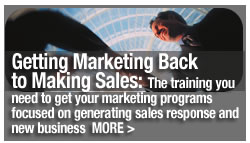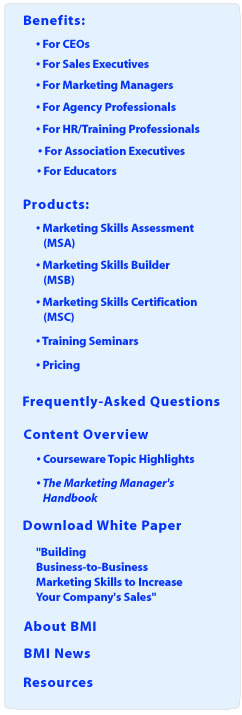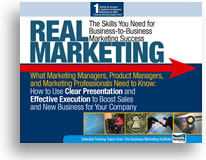



 |
 |
 |
 |

Tuesday Marketing Notes (Number 79—May 15th , 2007)
MAKE SURE YOU CONTINUE TO RECEIVE EACH ISSUE OF TUESDAY MARKETING NOTES—CLICK HERE TO RENEW YOUR FREE SUBSCRIPTION
(NOTE: If you’ve already signed up previously at this link, no need to do so again)
Set it and Forget it Marketing? Um. No. Not Exactly:
Applying the Human Touch to Marketing Automation Systems
by Ardath Albee
I'm reading a lot of collateral from CRM and marketing automation companies that tout the "set it and forget it"option for automated campaigns, which has me scratching my head. In an age of interaction and customer centricity, I just can't see how anything you "forget" about is going to help build relationships that increase revenues through customer acquisition. Treating your prospects as forgone conclusions is not appealing and probably won't meet the individual and complex needs of B2B buyers.
What’s more, features of marketing automation systems, such as lead scoring, only scratch the surface. This technique may be appropriate for a simple sale or a lead nurturing campaign, but for a B2B complex sale where your company needs to build a relationship, chances are it’s not nearly enough. If all you do is have your system assign a number based on the actions of your leads and then you toss them over the wall to sales, how do you know WHY they are taking those actions? What stage of the buying cycle are they in? Does the lead who's looking have buying decision authority?
Utilize “digital body language” for better insights: The activity of your email recipients will allow you to prioritize where you focus marketing efforts. But, responding to the actions taken by the prospects who respond to your e-mail messages is where personalization and research play key roles. By operating from intelligence, instead of intuition, you can build relationships that drive revenue.
A B2B complex sale requires multiple interactions to create a relationship. Relationships are based on trust. Trust takes time. When your sales rep calls every prospect immediately after the prospect downloads your company’s white paper, this shows your prospect that your company’s interest is all about itself and about making the sale, not about the prospect. Instead, focus on exploring the prospect’s interest and learn more about them so you can establish a relationship based on what’s important to them. Relevance is key.
Does the next email you send build the right story based on the link the recipient clicked on from the last email? How does what they looked at most recently compare to what they've looked at in the past? How does it influence what you send next?
The effectiveness of your marketing communications is based on context. Make sure you’re reading the context correctly. This means you need to send several related emails that further qualify prospects based on continued interest. If your prospect reads one email based on streamlining their product development processes, but ignores the next three you send, perhaps their interest was in something different or their focus has changed. This is where marketing automation that builds profiles is extremely valuable.
Calls to action need to be informative for both you and the prospect. Think about what you’ll learn if a prospect expresses interest by clicking on a link, downloading a whitepaper or registering for a webinar. Contextual relevance goes both ways. The way you structure interactions, and the information you collect about them, should build an interest profile that can be used to further the dialogue. But, you have to use the collected knowledge intelligently. Attention must be paid to what the prospect’s actions show you over time. Not knee-jerk responses to one-time behavior.
A frustrating experience with “set-it-and-forget-it” marketing automation can turn your prospects away from further interactions. Here’s an example: I recently purchased a book on gardening for a gift. From that point on, the site I purchased from sent information about gardening that I couldn't care less about. Their automated system "scored" my actions. It was beyond irritating for a long time. The messages finally stopped, so I guess my inaction finally penetrated the automated processes after a specific length of time.
Customer centricity, or lack thereof, is reflected by your marketing. What I now know about that book company is they really don't care, they just have their system set to make assumptions and react, regardless of what I'm interested in over the long term. And many companies operate the same way. Do you think your customers, leads, or prospects will appreciate that kind of treatment?
If you are tempted to use the "set it and forget it" approach with marketing automation, the key is not to forget it for too long. Here are the benefits I can see for using this approach in the early stages of lead nurturing:
- Digital cold calling: Use “set it and forget it” only for the first few emails, or until the recipient takes action;
- Building relevance expectations: Once the recipient has taken action, utilize personalized follow-up communications to learn more about them and showcase how your company's expertise can deliver a desired outcome;
- Nurturing longer-term leads: If the sale is outside the current horizon, then assign them to a campaign that focuses on their interests. But don't "forget" about them
I'm not dissing marketing automation. I'm all for it. What I don't want to see is what happened during the first blush of CRM installations where everyone thought the technology would magically transform sales results.
Knowing what prospects do is powerful. The problem with many CRM implementations was getting reliable data into the system. The problem with marketing automation is discerning which behavior, or chain of interactions, can be relied on to move the prospect through the sales pipeline to the point where they welcome sales activities.
Marketing Automation is the prelude to effective CRM. By taking a role that pushes marketing effectiveness further downstream in the sales process, sales will have the knowledge and insights they need to enter the conversation seamlessly. Positioning sales activities at the right time in the buying cycle means sales can do what sales is supposed to do: Sell.
Utilized well, marketing automation has a lot of great potential outcomes. A few are:
- An actionable lead list: There’s a big benefit to quickly culling through a large list of leads to focus on those who respond to messaging with personalized interactions and directed follow-up. This saves a lot of wasted effort in pursuing leads not ready for action;
- Predictable outcomes: As more and more data is collected in Marketing Automation systems, your company will gain visibility into how to build trusted relationships with prospects. By accessing real-time digital behavior in response to your campaigns, you’ll be able to tweak and tune your communications to achieve best-outcome scenarios;
- Streamlining the buying cycle: Collecting activity profiles and proactively personalizing interactions to what a lead, prospect, or customer expresses interest in, and then streamlining the buying cycle through that focus;
- Verifiable business results: Generating quantifiable marketing metrics related to the business results produced from marketing efforts commands more respect from the executive team and can result in marketing getting a bigger stake in strategic responsibilities
However, none of these outcomes happen in a vacuum. Using the "set it and forget it" technique with restraint can produce outcomes that streamline marketing processes and focus efforts where they can make a difference in sales outcomes. The market changes over time, quite often more rapidly that is easily responded to. Monitoring digital behavior in Marketing Automation systems and leveraging those insights takes patience and dedication, but the payoff can be huge.
If you use the "set it and forget it" method because it's easy and don’t bother with personalized interactions based on customer-centric values, the outcome will probably be regret:
- Regret for lost opportunities to build lasting, meaningful relationships;
- Regret that you irritated a potential prospect enough for them to opt out of your communications program;
- Regret that your competitors spent more effort personalizing and won the sale;
- Regret that you don't have any further insights into your lead base, other than basic lead scoring and ranking,
Marketing Automation is a great tool that can help marketing efforts deliver higher value results than what's been achievable in the past. But, like any tool, what matters is how you use it.
But then, isn't that always the case?
Next week, we’ll discuss how to quit using email to train your sales leads to ignore you . . .
Ardath Albee (ardath@marketinginteractions.com) is an expert marketing strategist in the field of B2B marketing. Ardath calls on over 22 years of marketing experience to empower clients to increase their marketing effectiveness, establishing marketing as a critical driver of corporate success. Her focus is on helping clients develop actionable customer relationships through leveraging contextual communication platforms. She also helps clients increase their return from in-place CRM and electronic marketing solutions, delivering an integrated and highly effective marketing system. Visit her website and industry-leading blog to learn more: www.marketinginteractions.com.
Real Marketing: The Skills You Need for Business-to-Business Marketing Success, a 47-page overview of content covered by the BMI MSA/B/C Training and Certification System




Login![]() Home
Home![]() Free Demo
Free Demo![]() Free Newsletter
Free Newsletter![]() Order Now
Order Now![]() Contact Us
Contact Us
Copyright 2005-2007 Business Marketing Institute, LLC

